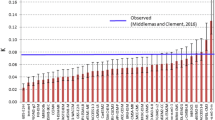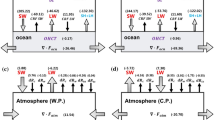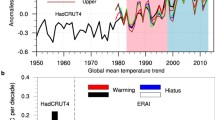Abstract
This study investigates relationships between daily variability in National Oceanographic and Atmospheric Administration (NOAA) outgoing longwave radiation (OLR), as a proxy for deep convection, and the global diabatic heat budget derived from reanalysis data sets. Results are evaluated based on data from ECMWF Reanalysis (ERA-Interim), Japanese 55-year Reanalysis (JRA-55) and Modern-Era Retrospective Analysis for Research and Applications (MERRA2). The diabatic heating is separated into components linked to ‘physics’ (mainly latent heat fluxes), plus longwave (LW) and shortwave (SW) radiative tendencies. Transient variability in deep convection is highly correlated with diabatic heating throughout the troposphere and stratosphere. Correlation patterns and composite analyses show that enhanced deep convection (lower OLR) is linked to amplified heating in the tropical troposphere and in the mid-latitude storm tracks, tied to latent heat release. Enhanced convection is also linked to radiative cooling in the lower stratosphere, due to weaker upwelling LW from lower altitudes. Enhanced transient deep convection increases LW and decreases SW radiation in the lower troposphere, with opposite effects in the mid to upper troposphere. The compensating effects in LW and SW radiation are largely linked to variations in cloud fraction and water content (vapor, liquid and ice). These radiative balances in reanalyses are in agreement with idealized calculations using a column radiative transfer model. The overall relationships between OLR and diabatic heating are robust among the different reanalyses, although there are differences in radiative tendencies in the tropics due to large differences of cloud water and ice content among the reanalyses. These calculations provide a simple statistical method to quantify variations in diabatic heating linked to transient deep convection in the climate system.

















Similar content being viewed by others
References
Bosilovich M, Lucchesi R, Suarez M (2015) MERRA-2: file specification. GMAO Office Note 9 (Version 1.0), p 73. https://gmao.gsfc.nasa.gov/pubs/office_notes/
Bretherton CS (2007) Challenges in numerical modeling of tropical circulations, vol 3026330. Princeton University Press, Princeton
Dee DP et al (2011) The ERA-Interim reanalysis: Configuration and performance of the data assimilation system. Q J R Meteorol Soc 137:553–597
Flannaghan T, Fueglistaler S (2011) Kelvin waves and shear-flow turbulent mixing in the TTL in (re-) analysis data. Geophys Res Lett 38:L02801
Fueglistaler S, Fu Q (2006) Impact of clouds on radiative heating rates in the tropical lower stratosphere. J Geophys Res Atmos 111:D23202
Fueglistaler S, Legras B, Beljaars A, Morcrette JJ, Simmons A, Tompkins A, Uppala S (2009) The diabatic heat budget of the upper troposphere and lower/mid stratosphere in ECMWF reanalyses. Q J R Meteorol Soc 135:21–37
Fung K, Ramaswamy V (1999) On shortwave radiation absorption in overcast atmospheres. J Geophys Res: Atmos 104:22233–22241
Gettelman A et al (2004) Radiation balance of the tropical tropopause layer. J Geophys Res Atmos 109:D07103
Gruber A, Krueger AF (1984) The status of the NOAA outgoing longwave radiation data set. Bull Am Meteorol Soc 65:958–962
Gruber A, Winston JS (1978) Earth-atmosphere radiative heating based on NOAA scanning radiometer measurements. Bull Am Meteorol Soc 59:1570–1573
Hartmann DL, Holton JR, Fu Q (2001) The heat balance of the tropical tropopause, cirrus, and stratospheric dehydration. Geophys Res Lett 28:1969–1972. doi:10.1029/2000gl012833
Hoskins BJ, Rodwell MJ (1995) A model of the Asian summer monsoon. Part I: the global scale. J Atmos Sci 52:1329–1340
Houze RA (1989) Observed structure of mesoscale convective systems and implications for large-scale heating. Q J R Meteorol Soc 115:425–461
Hu Y, Fu Q (2007) Observed poleward expansion of the Hadley circulation since 1979. Atmos Chem Phys 7:5229–5236
Iacono MJ, Mlawer EJ, Clough SA, Morcrette J-J (2000) Impact of an improved longwave radiation model, RRTM, on the energy budget and thermodynamic properties of the NCAR community climate model, CCM3. J Geophys Res 105:14873–14890
Johnson RH, Rickenbach TM, Rutledge SA, Ciesielski PE, Schubert WH (1999) Trimodal characteristics of tropical convection. J Clim 12(8):2397–2418
Kikuchi K, Takayabu YN (2004) The development of organized convection associated with the MJO during TOGA COARE IOP: trimodal characteristics. Geophys Res Lett 31(10)
Kobayashi S et al (2015) The JRA-55 reanalysis: general specifications and basic characteristics. J Meteorol Soc Jpn 93:5–48
Li C, Jia X, Ling J, Zhou W, Zhang C (2009) Sensitivity of MJO simulations to diabatic heating profiles. Clim Dyn 32:167–187
Liebmann B, Smith CA (1996) Description of a complete (interpolated) outgoing longwave radiation dataset. Bull Am Meteor Soc 77:1275–1277
Ling J, Zhang C (2013) Diabatic heating profiles in recent global reanalyses. J Clim 26:3307–3325
Mlawer EJ, Taubman SJ, Brown PD, Iacono MJ, Clough SA (1997) Radiative transfer for inhomogeneous atmospheres: RRTM, a validated correlated-k model for the longwave. J Geophys Res Atmos 102:16663–16682
Molod A, Takacs L, Suarez M, Bacmeister J (2015) Development of the GEOS-5 atmospheric general circulation model: evolution from MERRA to MERRA2. Geosci Model Dev 8:1339–1356
Nigam S, Chung C, DeWeaver E (2000) ENSO diabatic heating in ECMWF and NCEP-NCAR reanalyses, and NCAR CCM3 simulation. J Clim 13:3152–3171
Norton W (2001) Longwave heating of the tropical lower stratosphere. Geophys Res Lett 28:3653–3656
Ohring G, Gruber A (1983) Satellite radiation observations and climate theory. Adv Geophys 25:237
Ohring G, Gruber A, Ellingson R (1984) Satellite determinations of the relationship between total longwave radiation flux and infrared window radiance. J Clim Appl Meteorol 23(3):416–425
Park M, Randel WJ, Gettelman A, Massie ST, Jiang JH (2007) Transport above the Asian summer monsoon anticyclone inferred from aura microwave limb sounder tracers. J Geophys Res Atmos 112:D16309
Ploeger F, Konopka P, Günther G, Grooß JU, Müller R (2010) Impact of the vertical velocity scheme on modeling transport in the tropical tropopause layer. J Geophys Res Atmos 115:D03301
Randel WJ, Zhang K, Fu R (2015) What controls stratospheric water vapor in the NH summer monsoon regions? J Geophys Res Atmos 120(15):7988–8001
Rienecker MM et al (2011) MERRA: NASA’s modern-era retrospective analysis for research and applications. J Clim 24:3624–3648
Schoeberl MR, Dessler AE, Wang T (2012) Simulation of stratospheric water vapor and trends using three reanalyses. Atmos Chem Phys 12:6475–6487
Schoeberl MR, Dessler A, Wang T (2013) Modeling upper tropospheric and lower stratospheric water vapor anomalies. Atmos Chem Phys 13:7783–7793
Wang T, Randel WJ, Dessler AE, Schoeberl MR, Kinnison DE (2014) Trajectory model simulations of ozone (O3) and carbon monoxide (CO) in the lower stratosphere. Atmos Chem Phys 14:7135–7147. doi:10.5194/acp-14-7135-2014
Wang T, Dessler AE, Schoeberl MR, Randel WJ, Kim JE (2015) The impact of temperature vertical structure on trajectory modeling of stratospheric water vapor. Atmos Chem Phys 15:3517–3526. doi:10.5194/acp-15-3517-2015
Wright J, Fueglistaler S (2013) Large differences in reanalyses of diabatic heating in the tropical upper troposphere and lower stratosphere. Atmos Chem Phys 13:9565–9576
Xie P, Arkin PA (1998) Global monthly precipitation estimates from satellite-observed outgoing longwave radiation. J Clim 11:137–164
Yang Q, Fu Q, Hu Y (2010) Radiative impacts of clouds in the tropical tropopause layer. J Geophys Res Atmos 115:D00H12
Zhang K, Fu R, Wang T, Liu Y (2016) Impact of geographic variations of the convective and dehydration center on stratospheric water vapor over the Asian monsoon region. Atmos Chem Phys 16:7825–7835. doi:10.5194/acp-16-7825-2016
Acknowledgements
We are grateful for useful discussions with Joowan Kim, Andrew Gettelman, and Thomas Birner, and thank an anonymous reviewer for constructive suggestions. The ERA-Interim diabatic heating datasets were retrieved via ECMWF Web API (https://software.ecmwf.int/wiki/display/WEBAPI/Access+ECMWF+Public+Datasets). We thank Dr. Shaikh Mohammad, Peirong Lin and Dr. Chen Zhou for technical support. The RRTM code was downloaded from http://rtweb.aer.com/rrtm_frame.html. This work was partially supported under the NASA Aura Science Team. The National Center for Atmospheric Research is operated by the University Corporation for Atmospheric Research, under sponsorship of the National Science Foundation.
Author information
Authors and Affiliations
Corresponding author
Electronic supplementary material
Below is the link to the electronic supplementary material.
Rights and permissions
About this article
Cite this article
Zhang, K., Randel, W.J. & Fu, R. Relationships between outgoing longwave radiation and diabatic heating in reanalyses. Clim Dyn 49, 2911–2929 (2017). https://doi.org/10.1007/s00382-016-3501-0
Received:
Accepted:
Published:
Issue Date:
DOI: https://doi.org/10.1007/s00382-016-3501-0




